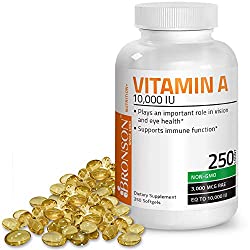Vitamin A
Always consult your primary physician when starting a nutrition program with Vitamin A.
Vitamin A is the name of a group of fat-soluble retinoids, including retinol, retinal, and retinyl esters [1-3]. Vitamin A is involved in immune function, vision, reproduction, and cellular communication [1,4,5]. Vitamin A is critical for vision as an essential component of rhodopsin, a protein that absorbs light in the retinal receptors, and because it supports the normal differentiation and functioning of the conjunctival membranes and cornea [2-4]. Vitamin A also supports cell growth and differentiation, playing a critical role in the normal formation and maintenance of the heart, lungs, kidneys, and other organs [2].
Two forms of vitamin A are available in the human diet: preformed vitamin A (retinol and its esterified form, retinyl ester) and provitamin A carotenoids [1-5]. Preformed vitamin A is found in foods from animal sources, including dairy products, fish, and meat (especially liver). By far the most important provitamin A carotenoid is beta-carotene; other provitamin A carotenoids are alpha-carotene and beta-cryptoxanthin. The body converts these plant pigments into vitamin A. Both provitamin A and preformed vitamin A must be metabolized intracellularly to retinal and retinoic acid, the active forms of vitamin A, to support the vitamin’s important biological functions [2,3]. Other carotenoids found in food, such as lycopene, lutein, and zeaxanthin, are not converted into vitamin A.


